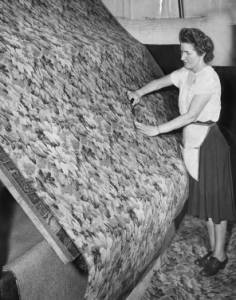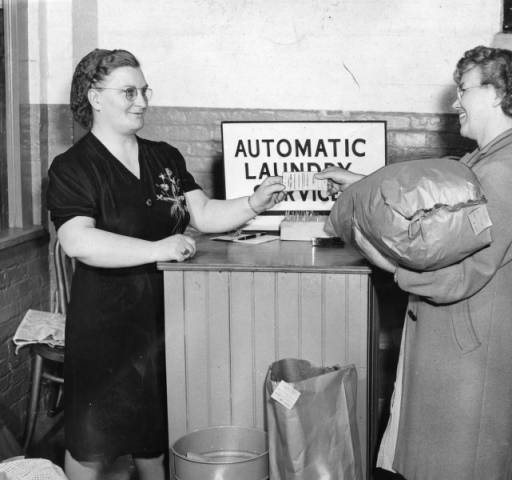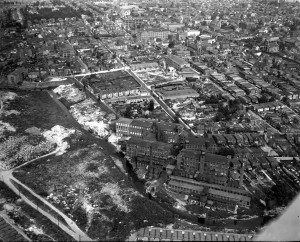Carpet Weaving and Rug Making
Essay
In its early twentieth-century heyday, Philadelphia’s carpet and rug industry represented this nation’s greatest concentration of factories making household and commercial floor coverings. The Public Ledger boasted that “two wards, in the northern section of the city, produce more carpets than the whole of Great Britain and Ireland.” Indeed, as early as 1882, those Kensington wards (the 19th and the 31st) held 141 carpet firms, valued at $12 million and employing over 6,000 workers.
Lorin Blodget, the nineteenth-century industrial statistician, estimated that 90 additional carpet and rug works operated elsewhere in the region. Altogether, the sector’s workforce ran more than 4,000 hand looms and 1,200 power looms in 1880, using an estimated 30 million pounds of raw wool to create some 33 million yards of output yearly, selling for just over $21,000,000.
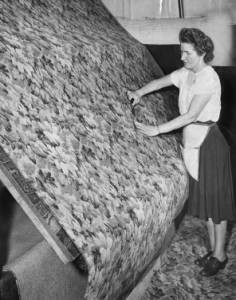
A century earlier, at the time of the Revolution, Philadelphia already was producing virtually all the carpets and floor cloths made in Pennsylvania. The carpets were mostly narrow, woven hall runners, whereas large floor cloths were created by oiling or waxing heavy canvas (like sail cloth, also a local textile), then painting bright, geometric designs on the smooth surface. Both were handmade. A third variety, chain braided rugs, were the result of recycling rags, which women workers cut into strips and sewed into long, multicolor ropes, the foundation for rectangular, oval, and circular rag rugs.
All three varieties persisted as main elements in Philadelphia industries. Floor cloths became linoleum flooring, following a British invention of the 1850s. Narrow runners became “‘broadloom”’ carpeting, woven from tough wools on looms six and nine feet wide, and rag rugs held sway at the bottom edge of the market, without technological innovations, well into the 1920s.
When Edwin Freedley surveyed Philadelphia manufacturing in 1857, he reported some 2,000 carpet looms in operation (500 on rag rugs), almost all for hand-weaving. The only power looms were located at McCallum and Co.’s “Glen Echo Mills” in Germantown. John Bromley & Sonohn Bromley and Son, in Kensington, offered top-of-the-line Ingrain supers and extra fines at 60 to 85 cents per yard, and Damask Venetians, “fully equal to the imported,” at $1.15. All-cotton rag rugs, by contrast, could be had at 20 cents the yard. The area’s 2,000 hand weavers each earned an estimated $300 per year in the late 1850s (roughly $55,000 in 2014 dollars). Small wonder that one textile industry observer dubbed Philadelphia “the paradise of the skilled workman.”
Troubles visited paradise, however, not least during economic downturns. As household goods, carpets, and rugs were far from being necessity purchases when budgets tightened. Thus sales collapsed when the national economy crashed, as it did in and after 1873, once America’s railway boom went bust. Kensington carpet mills allied to announce rate cuts, but workers went on strike in response, setting off a decade of conflict and a decided effort by the larger firms to install power looms and hire “more docile” women weavers. Although the manufacturers rarely remained united for long, one result of the mid-1870s crisis was durable–creation of the American Carpet and Upholstery Journal, the trade’s core magazine, published in Philadelphia until the mid-1940s.
Hand looms remained effective in fine carpet weaving through the 1880s partly due to the difficulty of speedily producing complex designs, especially those generated through use of a Jacquard mechanism. The “Jacquard chain” was a sequence of punched cards, each of which represented one line’s setting for weaving an elaborate pattern. Holes on every card allowed internal hooks each to raise one warp thread before the filling shuttle passed through. The next card then slipped into place, governing the next throw of the shuttle. Moving the chain rapidly, as a power loom would, risked weaving errors, so the hand weaver’s close attention to the process long remained essential. Reportedly, Charles Babbage transferred the punched-card idea from weaving to computing in 1839, having marveled at a silk portrait of Jacquard, produced by a 24,000-card set.
The 1880s’ erratic markets and owner-worker battles proved disastrous for small firms, especially hand-weaving ones, in carpets and rugs. Though roughly the same workforce occupied mill places in 1893 as in 1880 (about 11,000 regionwide), the number of firms dropped by two-thirds, from about 300 to 99. Whereas nearly 14,000 textile jobs could be found in Philadelphia’s suburban counties in about 1893, fewer than five percent of these (690) lay in the carpet trades. Then and thereafter, carpet weaving was a city business.
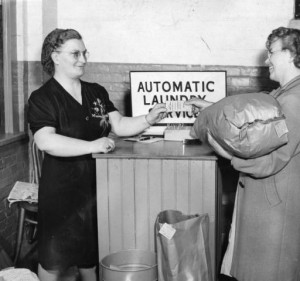
The most important carpet mills outside Kensington were those of James and John Dobson, English immigrant brothers whose massive factory complex at the Falls of Schuylkill employed thousands in a set of ‘integrated’ mills. Unusual for Philadelphia, the Dobsons spun and dyed their own yarns, then used them to weave blankets, worsted woolens, mohair plushes (for upholstery), and a broad array of carpetings. When the factory complex burned spectacularly in January 1891, some 4,800 workers faced instant unemployment. Eight mills were lost, but the plush factory remained, anchoring a thousand jobs. Within a week, about a thousand of the male workers commenced sorting through the wreckage as the first step to rebuilding. Still, over half the Dobson workers, chiefly women, had to seek temporary positions in Germantown or Manayunk, until the mills reopened, one by one, during the summer. Six years later, as the effects of the mid-1890s depression wore off, Pennsylvania’s factory inspector counted over 4,500 workers in the Dobson’s four “departments,” half of them (2,245) running carpets. This force included 1,110 adult men, 720 adult women, and 425 workers under 21, of whom 135 were 16 or younger. Unlike largely-feminized cotton weaving, carpets relied on thousands of skilled male workers, even in the power loom era.
Such men readily (and repeatedly) organized trade unions to advance their wage scales (different piece rates for varied types of carpets), and, in hard times, defended them. Owners, allied in the carpet “‘sections”’ of the Textile Manufacturers Association, worked relentlessly to protect their profits and privileges in the early twentieth century. But a more potent threat than walkouts gathered by the World War I era: Carpet mill mergers and brand name promotions that gradually turned the market tide against Philadelphia’s high-end but largely unbranded goods. With New England’s Bigelow-Hartford and New York’s Alexander Smith leading emergent price wars in the 1920s, Philadelphia mills ran full only in busy markets and were the first to feel the slack of downturns. When Bigelow hatched another carpet merger in 1929, not one Philadelphia area company was invited to join the new enterprise. Indeed, as branding became central to selling, only Hardwick and Magee, among the city’s leading companies, was able to establish national visibility.
The Great Depression greased the downward slope. Of 9,500 carpet workers active in 1925, just 4,000 remained at work in 1934. During World War II, carpets were anything but necessities. Mills either closed or turned to making blankets, tarpaulins, and other military fabrics. The postwar advance of a new technology, weft-inserted tufted carpeting, usually inexpensive in solid colors, expressed a 1950s modernism in home decoration that devalued the elaborate designs, the complex machinery, and the skilled workforce that long made Philadelphia the apex of the American carpet manufacture. The last survivor, Kensington’s Pennsylvania Woven Carpets, continued to produce woolen Jacquard-made Wilton specialties well past the turn of the twenty-first century, a fading echo of a memorable era.
Philip Scranton is Board of Governors Professor of History Emeritus at Rutgers University-Camden. He has published widely on Philadelphia’s industrial history. He is researching steadily changing business practices in post-1945 developed, developing, and socialist nations. (Author information current at time of publication)
Copyright 2015, Rutgers University

